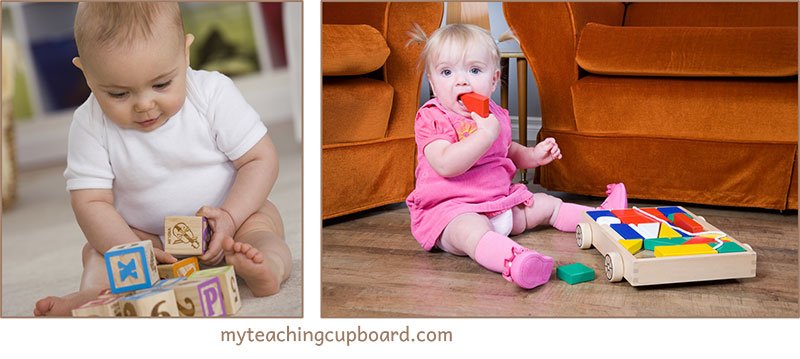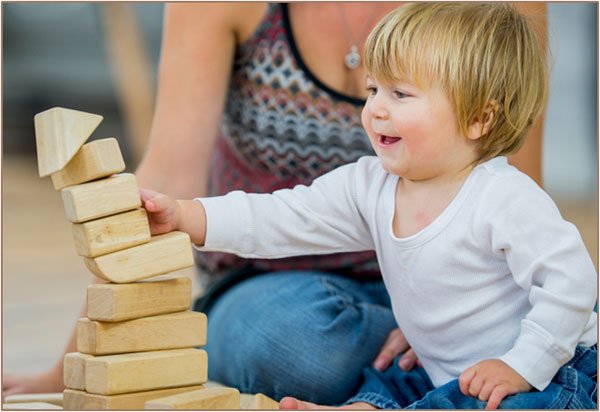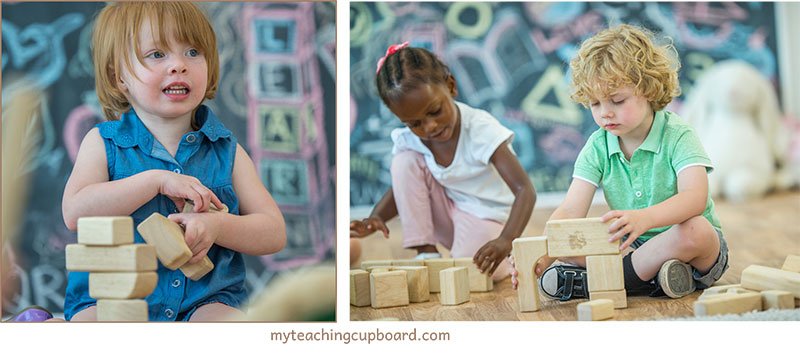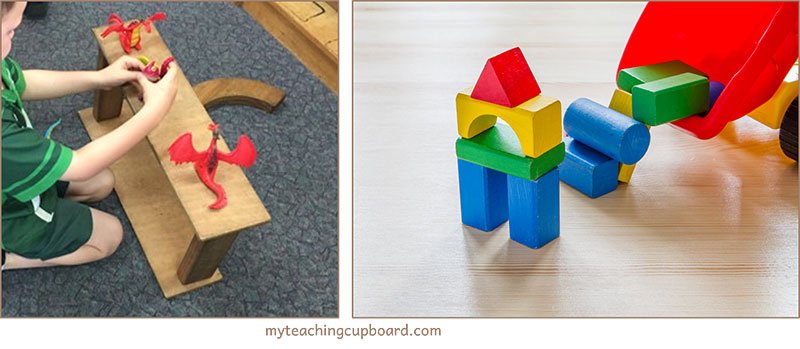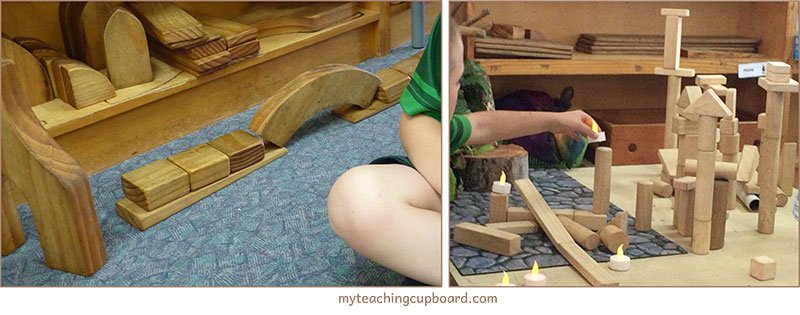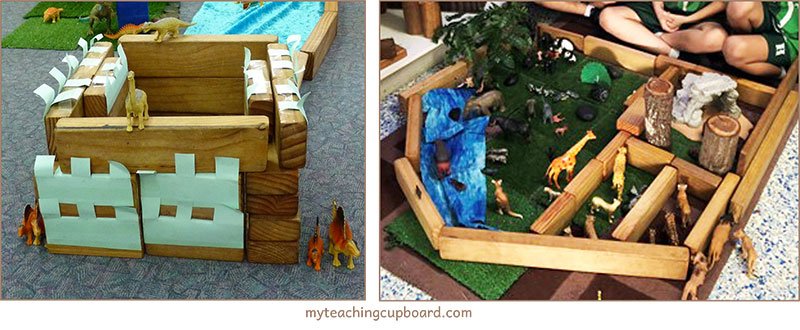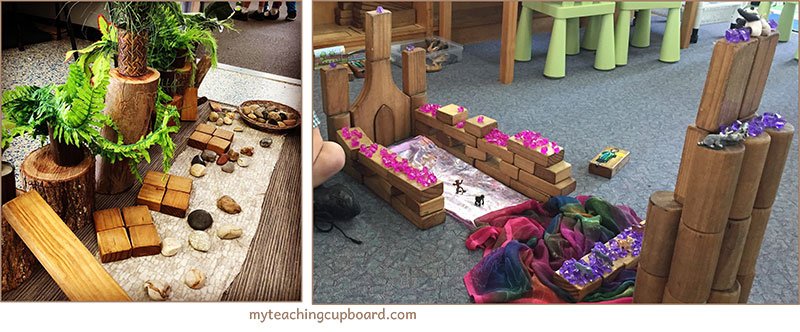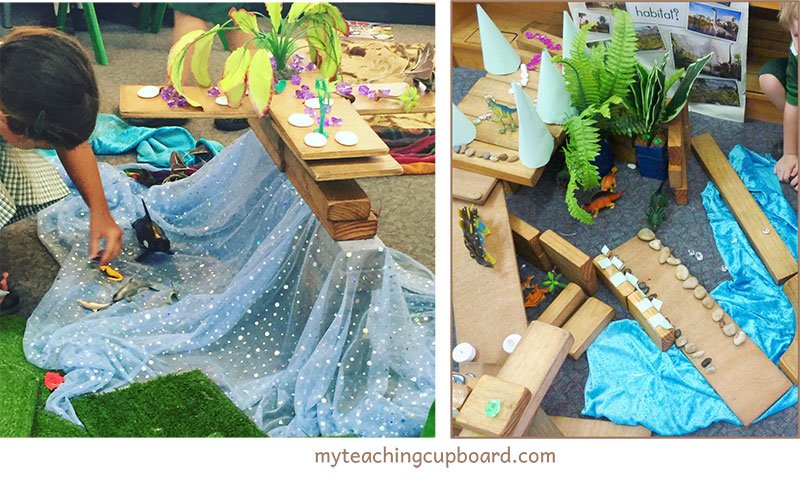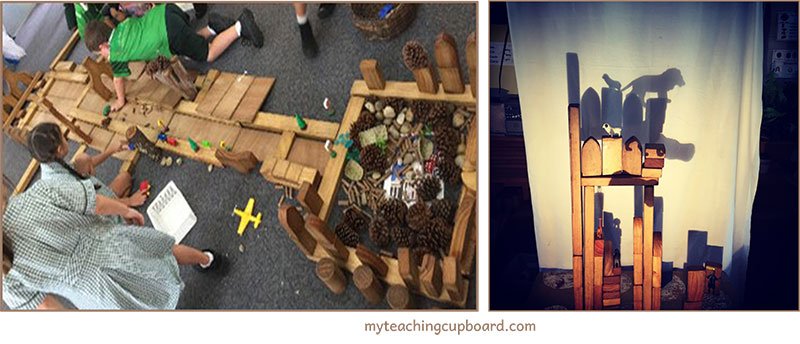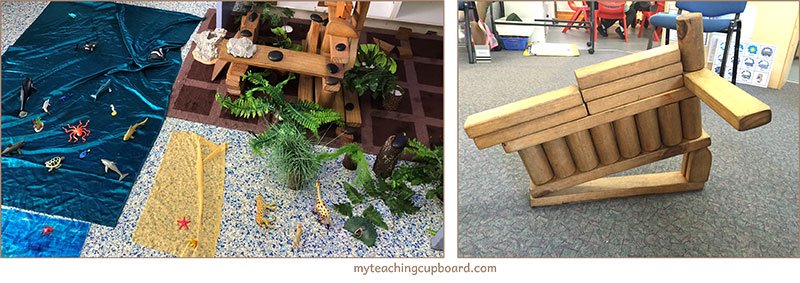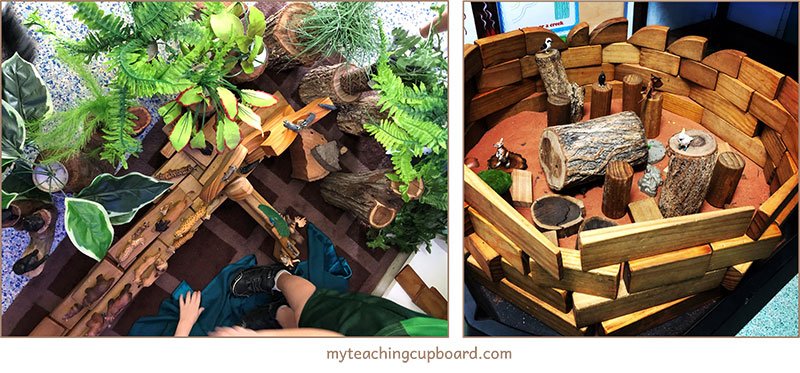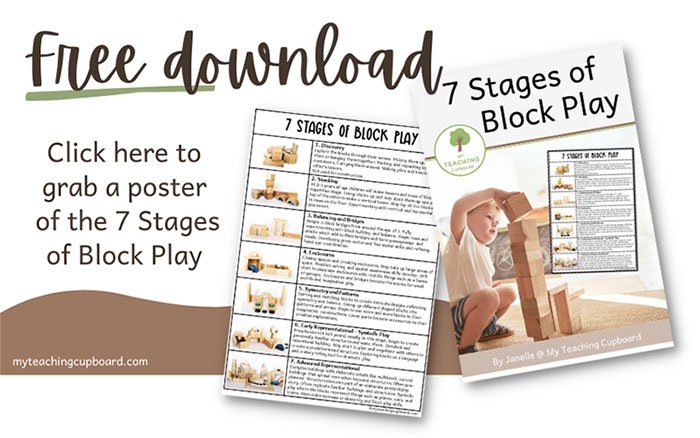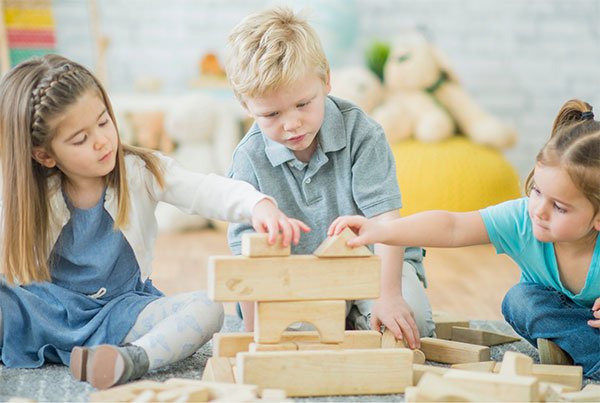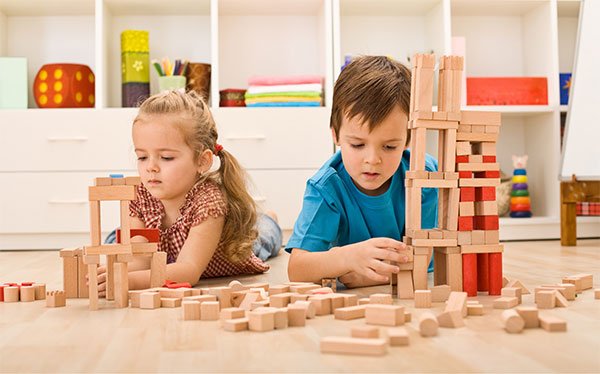Stages of Block Play
You are probably aware that block play teaches mathematical and scientific skills and concepts to your children, but did you know there are developmental stages of block play?
In this blog post you will discover the seven stages of block play and the influences these stages can have to the design of your learning environment.
Children often advance through these stages in order, but not always. Once they have mastered a stage, it is not uncommon for a child to move back and forth between the stages.
Stage 1 of Block Play: Discovery
You will observe this first discovery stage of block play in very young children, such as babies and toddlers. In this stage the children will first explore the blocks through their senses. Babies will be picking up and dropping the blocks and mouthing them. They will explore the sounds blocks make by dropping them or banging them together. This is the stage that they learn about the blocks and what they can do.
You will notice toddlers packing and repacking them and carrying them around. Toddlers will benefit from the addition of a range of containers to the blocks area.
In this first stage of block play, children like to pile the blocks up, but the blocks are not used for construction. Instead, they are used as tools to support sensorimotor development. The children like the process of knocking the blocks down so it’s common to observe them knocking down a tower that you built together or an older child's creation.
Stage 2 of Block Play: Stacking
At around 2-3 years of age, you will observe block building and basic constructions start. In the stacking stage children will make towers and rows of blocks. This is very much a repetition stage. They will line the blocks up and may stack them up one on top of the other to make a vertical tower.
Sometimes in this stage children will lay all the blocks out in rows on the floor. They will experiment with both vertical and horizontal placement. You will notice many repetitions in their "building." Children in this stage will repeat patterns until they work out the next step in the stages of block play.
Children in the stacking stage can usually build:
A tower with 2 blocks from approximately 15 months of age
A tower with 3 blocks from approximately 18 months of age
A tower with 6 or 7 blocks from age 2
A tower with over 7 blocks from 2 and a half
Stage 3 of Block Play: Balancing and Bridges
Children in the third stage of block play are usually able to build simple 3-block bridges from around the age of 3. At this stage, most 3-4 year olds begin to fully experiment with block building. They start by placing two blocks apart to support the third block. This creates a "bridge," also known as bridging.
Children in this stage will eventually build rows and stacks which add to their bridges and form passageways. Experimentation is the foundation of block play in this stage as the children will be learning primarily by trial and error. They will discover how to balance the blocks and construct strong bridges and passages.
Block building is important for developing gross motor and fine motor skills in this age group. Block play will also refine the children’s hand-eye coordination.
As you observe children in this stage of block play you will observe their imagination emerge as they start to use props such as trucks and cars to turn blocks into "roads."
Stage 4 of Block Play: Enclosures
By around age 4, after children begin to use blocks regularly, they move from building bridges into closing up spaces and creating enclosures. You will observe children in this stage expand their block constructions to take up large areas of space like your whole carpet area.
Problem solving comes to the forefront in this stage of block play. When children begin to construct complex bridges and enclosures, they will need to develop their spatial awareness skills so they can successfully close in areas.
When children start to build enclosures, they will start to associate them with things such as a barns for toy animals or as a garage for their cars. This is the beginning stage of dramatic play with blocks.
At this stage you can help your children’s block play development by offering props like small dolls, animals, and toy cars. Enclosures and bridges become the scenes of small worlds and imaginative play.
Stage 5 of Block Play: Symmetry and Patterns
Symmetry and patterning emerge in this stage of block play. You will observe children developing foundational mathematical and scientific skills like sorting and matching the blocks. They will need these skills to create intricate designs reflecting symmetry and balance.
Symmetry and balance become more and more prevalent in the constructions at this stage of block play. You will notice the children lining up all the different shaped blocks into patterns and arrays.
The shelf will become increasingly bare as they use more and more blocks in their constructions. The block constructions of this stage are very imaginative. Imaginative play has its beginnings in the third stage of block play but in this fifth stage, creativity appears.
Everything and anything will become an accessory to their block constructions. This is the perfect time to add a selection of loose parts to the blocks area. Consider adding loose parts which assist in their explorations of symmetry and balance. Small mirrors, counters, rocks, or glass gems are perfect loose parts to add at this stage.
Imaginative play is still an important aspect of this stage so do not take away the props added in the last stage. They will still be used but in a more strategic fashion and in a more advanced form of imaginative play.
Stage 6 of Block Play: Early Representational – Symbolic Play
Preschoolers are usually in this stage, and you may find they only progress to the next stage when they are a bit older.
At around 4 to 5 years of age children in the early representational stage of block play begin to name their structures. Their play takes on a more functional characteristic as they begin to create personally familiar structures.
You will observe the constructions in this stage are quite detailed and the children seem much more intentional with their building. You may even notice some children planning and negotiating with others to create a predetermined structure. They may work together cooperatively or individually.
In the previous stages of block play the children might have named their structures but they probably have not named their constructions based on the function of the building.
In this stage dramatic play becomes an essential component of their constructions. Children explore the world of blocks as a language and a story telling tool. Block play will help the children in this stage to understand the world around them.
You will help your children developmentally move through this stage by offering them a larger variety of blocks to build with. Consider blocks made from different materials and blocks of different sizes and shapes. Consider changing up the props and loose parts offered in this area too.
Stage 7 of Block Play: Advanced Representational
At about school age (5+ years), this advanced representational stage takes on more complex buildings with elaborate details. The children usually say what they are going to build before they start as they are developing their planning abilities and can strategically think before beginning a task.
Block play in this later representational stage stimulates imaginative play, and their structures will become part of an elaborate pretend play story. The children’s cooperative play is also developing, and you will often find them negotiating what to build, how to build it, and who will play what role.
Children in this stage of block play usually try to replicate buildings and structures that they’re already familiar with like a school, shop, or play center. They will engage in symbolic play as they use the blocks to represent things such as planes, cars, and trains. You will observe complex constructions like multilevel, curved buildings that sprawl over other toys and structures.
This is when real dramatic play begins and children display so much creativity in their creations. You will observe a noticeable increase in their dexterity and block play skills.
Beyond Stage 7 of Block Play
We can use numbers to communicate in maths and words in language, blocks can also have their own meaningful way of communicating. A block can stand for an object in the world and be combined in ways that can be read and understood by others.
At around 6 and 7 years of age children seem to become less interested in block play. At around this age they are old enough to competently use paints and clay as a symbolic language to communicate and blocks seem to have served their purpose and usefulness as an expressive material.
7 Stages of Block Play Poster
If you would like a printable poster as an easy reminder of the stages of block play you can download this FREE printable – 7 Stages of Block play pdf from my FREE Resources Library. Print it out and keep it in your blocks area as a reference when you are observing your children playing with your classroom blocks.
What are the benefits of block play?
When your children are given the opportunity to play with blocks, they will develop mathematical and scientific skills like classifying and sorting, problem solving and number and measurement concepts. Block play will also develop your children’s gross and fine motor skills.
Other developmental benefits you will observe include the development of your children’s oral language as they negotiate and talk about the structures they have built. Block play has also been linked to an increase in creativity, imagination, self-esteem, and social and emotional growth too.
What strategy will help children progress through the stages of block play?
That’s easy!! All you need to do is give your children lots of time and opportunities to play with blocks. If your children have access to blocks and the time to explore them independently, they will naturally progress through these stages.
Froebel Stages of Block Play
When Friedrich Froebel (1782-1852) gave his cousin a set of wooden blocks for her two young sons as a present and asked her to observe how they played with them, he gave us two gifts in one – a practical resource designed for children’s learning and free play AND an invitation to observe and reflect on our practice.
If you would like to know more about Frobel’s gifts and stages of block play, you might be interested in this download – Froebel’s Gifts and Block Play Today by Jane Whinnett MBE
This free download is an excellent resource with information on
the stages of block play
how blocks are a symbolic language
the teacher’s role in block play
how to set up block play in your setting
and so much more!!
This 24 page colour pamphlet produced by the Froebel Trust is well worth checking out.
If you liked this blog post on the Stages of Block Play, please consider sharing it...
Just CLICK the sharing box below.👇


